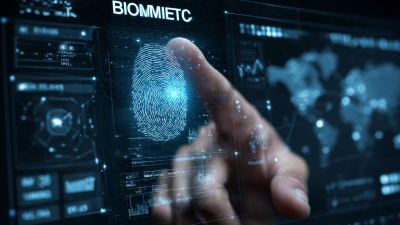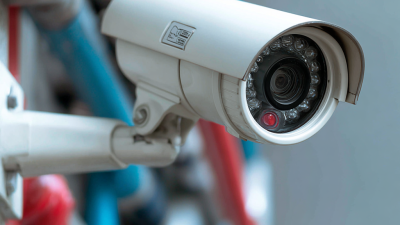Blog
How to Enhance Security and Efficiency with Biometric Access Control Systems
In an increasingly digital world, security challenges continue to evolve, necessitating advanced solutions to protect sensitive information and resources. Biometric Access Control systems have emerged as a cutting-edge technology that not only enhances security but also improves operational efficiency. Utilizing unique biological traits such as fingerprints, facial recognition, and iris patterns, these systems provide a highly personalized and secure method of access compared to traditional keys or passwords.

As organizations seek to safeguard their assets while streamlining processes, understanding how to implement and optimize Biometric Access Control is essential. This guide will explore various strategies and best practices for enhancing both security and efficiency through the adoption of biometric technologies, ensuring that businesses remain competitive and secure in a fast-paced environment.
Benefits of Biometric Access Control for Enhanced Security and Efficiency
Biometric access control systems provide a revolutionary approach to security by utilizing unique physical characteristics such as fingerprints, facial recognition, and iris patterns. These systems enhance security significantly by ensuring that only authorized personnel can gain entry to sensitive areas, thereby reducing the risk of unauthorized access. By relying on biometrics, organizations minimize the vulnerabilities associated with traditional access methods like passwords or keycards, which can be lost, stolen, or replicated.
In addition to bolstering security, biometric systems improve operational efficiency. They streamline the authentication process, allowing for quick and seamless entry, which is particularly beneficial in high-traffic environments. Employees spend less time waiting to access secure areas, leading to enhanced productivity. Furthermore, biometric data collection can facilitate better attendance tracking and workforce management, ensuring that organizations maintain optimal staffing levels while also securing their premises more effectively. The combination of security and efficiency makes biometric access control an attractive solution for modern organizations.
| Benefit | Description | Impact on Security | Impact on Efficiency |
|---|---|---|---|
| Increased Accuracy | Biometric systems reduce the risk of identity fraud by accurately verifying users' identities through unique physical traits. | Significantly enhances security against unauthorized access. | Streamlines the user authentication process, reducing wait times. |
| Cost Savings | Although initial setup costs can be high, biometric systems reduce long-term costs related to lost cards and manual entry. | Decreases risk management expenses associated with security breaches. | Minimizes administrative effort needed for access control management. |
| User Convenience | Eliminates the need for physical access cards or remembering passwords, making access seamless. | Enhanced user satisfaction and perceived security. | Increases productivity by minimizing time spent on access procedures. |
| Scalability | Biometric systems can easily be expanded to include more users or locations without significant overhauls. | Retains strict security protocols as the system grows. | Facilitates quick onboarding for new employees or facilities. |
| Integration Capabilities | Can often integrate with existing security systems for enhanced functionality. | Strengthens overall security management system by combining multiple technologies. | Improves operational efficiency by centralizing access control processes. |
Key Types of Biometric Authentication Technologies Explored
Biometric authentication technologies have revolutionized security protocols by offering unique methods for verifying identity. Among the primary types are fingerprint recognition, facial recognition, iris scanning, and voice recognition. Fingerprint recognition is one of the most widely used forms due to its convenience and reliability. This technology captures the unique patterns of an individual's fingerprint, allowing for quick and accurate access control.
Similarly, facial recognition systems analyze facial features and patterns, enabling automated identification suitable for various applications, from smartphones to high-security environments.
Iris scanning provides an even higher level of accuracy by analyzing the intricate patterns found in the colored part of the eye. This method is gaining traction in sensitive sectors like finance and government, where security is paramount. Voice recognition is another intriguing technology that analyzes voice patterns and tones for authentication. While it offers a hands-free option, its effectiveness can be influenced by background noise and vocal changes. Each of these biometric approaches enhances security and streamlines access processes, presenting organizations with a robust means to safeguard their assets while ensuring efficiency.
Best Practices for Implementing Biometric Access Control Systems
Implementing biometric access control systems can significantly enhance security and operational efficiency in organizations. However, to ensure their effectiveness, it is crucial to follow best practices that consider not only security measures but also ethical and legal implications of biometric data usage.

Tips for Effective Implementation:
First, prioritize compliance with privacy regulations. Organizations should stay informed about guidelines governing biometric data, particularly regarding necessity, consent, and proportionality. This helps establish trust with users and minimizes potential legal risks.
Additionally, conduct thorough assessments of biometric technologies before deployment. Analyze the specific needs of your organization and identify solutions that align with those needs while providing robust data protection. Regular audits and updates should be part of your strategy to address emerging security threats and ensure the systems remain effective.
Lastly, invest in employee training to promote awareness about biometric privacy and security challenges. Educating staff on the ethical implications and proper usage of biometric systems will create a culture of security within the organization, helping to prevent misuse and data breaches.
Addressing Privacy Concerns with Biometric Security Solutions
The growing adoption of biometric access control systems brings significant advantages, especially in addressing privacy concerns associated with security technologies. As the global biometric market is projected to expand from $18 billion in 2024 to over $56 billion by 2033 at a compound annual growth rate of 13.20%, it’s essential to consider how these systems can safeguard users' sensitive data. Biometric solutions offer a unique advantage as they use individual physical characteristics, such as fingerprints or facial recognition, which are inherently more secure than traditional passwords or access methods that can be easily compromised.
Moreover, as digital identity solutions gain traction—expected to surpass $27.9 billion in market size by 2023—organizations must prioritize user privacy to foster trust among their client bases. By implementing technologies that prioritize secure data encryption and user consent, businesses can alleviate apprehensions surrounding biometric data misuse. These advancements in security protocols not only help protect against unauthorized access but also reassure users that their biometric information is handled with the utmost care and responsibility, reinforcing confidence in these innovative systems.
Future Trends in Biometric Access Control System Development
As biometric access control systems continue to evolve, future trends are expected to shape their development in significant ways. One prominent trend is the integration of artificial intelligence (AI) to enhance the accuracy and speed of biometric recognition. AI algorithms can process vast amounts of data, allowing for real-time verification while minimizing false positives and negatives. This advancement will lead to systems that not only recognize individuals with exceptional precision but also adapt to new patterns of use, thereby offering a more streamlined and secure user experience.

Another emerging trend is the focus on privacy and data protection. With increasing concern over personal data security, future biometric systems will likely incorporate advanced encryption techniques and data anonymization processes to safeguard user information. Manufacturers are expected to balance user convenience with robust privacy features, such as on-device processing that limits data transmission. Additionally, policymakers may establish stricter regulations concerning biometric data usage, compelling developers to innovate solutions that prioritize compliance while maintaining user trust.
Related Posts
-

Understanding Global Industry Standards for the Best Biometric Access Control Solutions
-

Ultimate Checklist for Selecting the Best Biometric Access Control Solutions for Global Buyers
-

Exploring the Impact of the Best Home CCTV System: What Makes It Essential for Modern Security?
-

How to Select the Best CCTV Camera System for Your Business Security Needs
-

Mastering Industry Compliance for the Best CCTV Camera Installation Guide
-

Exploring the Best Commercial Access Control Systems: A Comprehensive Comparison Guide
